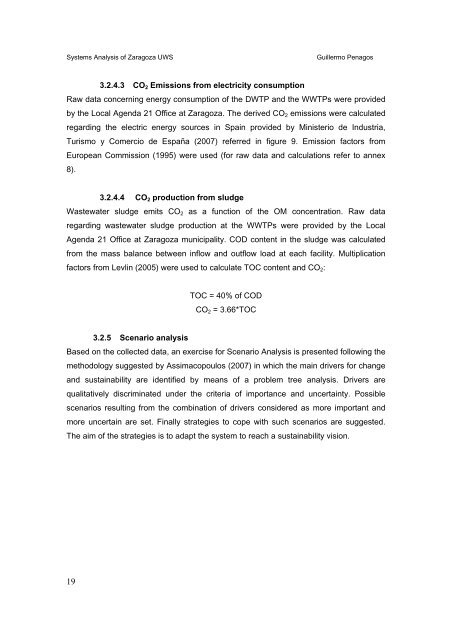Systems Analysis of Zaragoza Urban Water - SWITCH - Managing ...
Systems Analysis of Zaragoza Urban Water - SWITCH - Managing ...
Systems Analysis of Zaragoza Urban Water - SWITCH - Managing ...
You also want an ePaper? Increase the reach of your titles
YUMPU automatically turns print PDFs into web optimized ePapers that Google loves.
<strong>Systems</strong> <strong>Analysis</strong> <strong>of</strong> <strong>Zaragoza</strong> UWS<br />
Guillermo Penagos<br />
3.2.4.3 CO 2 Emissions from electricity consumption<br />
Raw data concerning energy consumption <strong>of</strong> the DWTP and the WWTPs were provided<br />
by the Local Agenda 21 Office at <strong>Zaragoza</strong>. The derived CO 2 emissions were calculated<br />
regarding the electric energy sources in Spain provided by Ministerio de Industria,<br />
Turismo y Comercio de España (2007) referred in figure 9. Emission factors from<br />
European Commission (1995) were used (for raw data and calculations refer to annex<br />
8).<br />
3.2.4.4 CO 2 production from sludge<br />
Wastewater sludge emits CO 2 as a function <strong>of</strong> the OM concentration. Raw data<br />
regarding wastewater sludge production at the WWTPs were provided by the Local<br />
Agenda 21 Office at <strong>Zaragoza</strong> municipality. COD content in the sludge was calculated<br />
from the mass balance between inflow and outflow load at each facility. Multiplication<br />
factors from Levlin (2005) were used to calculate TOC content and CO 2 :<br />
TOC = 40% <strong>of</strong> COD<br />
CO 2 = 3.66*TOC<br />
3.2.5 Scenario analysis<br />
Based on the collected data, an exercise for Scenario <strong>Analysis</strong> is presented following the<br />
methodology suggested by Assimacopoulos (2007) in which the main drivers for change<br />
and sustainability are identified by means <strong>of</strong> a problem tree analysis. Drivers are<br />
qualitatively discriminated under the criteria <strong>of</strong> importance and uncertainty. Possible<br />
scenarios resulting from the combination <strong>of</strong> drivers considered as more important and<br />
more uncertain are set. Finally strategies to cope with such scenarios are suggested.<br />
The aim <strong>of</strong> the strategies is to adapt the system to reach a sustainability vision.<br />
19
















